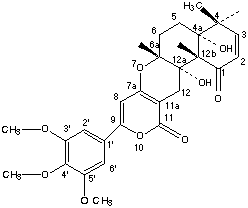TerritremB
Mycotoxin purified from culture of fungus Aspergillus terreus 23-1 growing on rice. TerritremB spans both catalytic and peripheral sites whereas dihydrotanshinone I binds only to the peripheral site (Cheung et al. 2013)
General
Type : Natural,Meroterpenoid
Chemical_Nomenclature : 4H,11H-Naphtho(2,1-b)pyrano(3,4-e)pyran-1,11(5H)-dione, 4a,6,6a,12,12a,12b-hexahydro-4a,12a-dihydroxy-4,4,6a,12b-tetramethyl-9-(3,4,5-trimethoxyphenyl)-, (4aR,6aR,12aS,12bS)-
Canonical SMILES : CC1(C=CC(=O)C2(C1(CCC3(C2(CC4=C(O3)C=C(OC4=O)C5=CC(=C(C(=C5)OC)OC)OC)O)C)O)C)C
InChI : InChI=1S\/C29H34O9\/c1-25(2)9-8-22(30)27(4)28(25,32)11-10-26(3)29(27,33)15-17-19(38-26)14-18(37-24(17)31)16-12-20(34-5)23(36-7)21(13-16)35-6\/h8-9,12-14,32-33H,10-11,15H2,1-7H3\/t26-,27+,28-,29-\/m1\/s1
InChIKey : PBXNNDFKPQPJBB-VJLHXPKFSA-N
Other name(s) :
MW : 526.20
Formula : C29H34O9
CAS_number : 70407-20-4
PubChem : 114734
UniChem : PBXNNDFKPQPJBB-VJLHXPKFSA-N
IUPHAR :
Wikipedia :

Target
Families : TerritremB ligand of proteins in family: ACHE
Stucture : 4M0F Structure of human acetylcholinesterase in complex with territrem B
Protein : human-ACHE
References (10)
| Title : Structures of Human Acetylcholinesterase Bound to Dihydrotanshinone I and Territrem B Show Peripheral Site Flexibility - Cheung_2013_ACS.Med.Chem.Lett_4_1091 |
| Author(s) : Cheung J , Gary EN , Shiomi K , Rosenberry TL |
| Ref : ACS Med Chem Lett , 4 :1091 , 2013 |
| Abstract : Cheung_2013_ACS.Med.Chem.Lett_4_1091 |
| ESTHER : Cheung_2013_ACS.Med.Chem.Lett_4_1091 |
| PubMedSearch : Cheung_2013_ACS.Med.Chem.Lett_4_1091 |
| PubMedID: 24900610 |
| Gene_locus related to this paper: human-ACHE |
| Title : Territrem B, a Tremorgenic Mycotoxin That Inhibits Acetylcholinesterase with a Noncovalent yet Irreversible Binding Mechanism - Chen_1999_J.Biol.Chem_274_34916 |
| Author(s) : Chen JW , Luo YL , Hwang MJ , Peng FC , Ling KH |
| Ref : Journal of Biological Chemistry , 274 :34916 , 1999 |
| Abstract : Chen_1999_J.Biol.Chem_274_34916 |
| ESTHER : Chen_1999_J.Biol.Chem_274_34916 |
| PubMedSearch : Chen_1999_J.Biol.Chem_274_34916 |
| PubMedID: 10574966 |
| Title : Effects of territrem-B on cholinergic responses of snail neuron - Arvanov_1993_Neurosci.Lett_152_69 |
| Author(s) : Arvanov VL , Ling KH , Chen RC , Tsai MC |
| Ref : Neuroscience Letters , 152 :69 , 1993 |
| Abstract : Arvanov_1993_Neurosci.Lett_152_69 |
| ESTHER : Arvanov_1993_Neurosci.Lett_152_69 |
| PubMedSearch : Arvanov_1993_Neurosci.Lett_152_69 |
| PubMedID: 8100056 |
| Title : NMR assignments of territrems A, B, and C and the structure of MB2, the major metabolite of territrem B by rat liver microsomal fraction - Lee_1992_J.Nat.Prod_55_251 |
| Author(s) : Lee SS , Peng FC , Chiou CM , Ling KH |
| Ref : Journal of Natural Products , 55 :251 , 1992 |
| Abstract : Lee_1992_J.Nat.Prod_55_251 |
| ESTHER : Lee_1992_J.Nat.Prod_55_251 |
| PubMedSearch : Lee_1992_J.Nat.Prod_55_251 |
| PubMedID: 1624944 |
| Title : Biotransformation of territrems by S9 fraction from rat liver - Ling_1991_Drug.Metab.Dispos_19_587 |
| Author(s) : Ling KH , Chiou CM , Tseng YL |
| Ref : Drug Metabolism & Disposition: The Biological Fate of Chemicals , 19 :587 , 1991 |
| Abstract : Ling_1991_Drug.Metab.Dispos_19_587 |
| ESTHER : Ling_1991_Drug.Metab.Dispos_19_587 |
| PubMedSearch : Ling_1991_Drug.Metab.Dispos_19_587 |
| PubMedID: 1680623 |
| Title : Isolation, chemical structure, acute toxicity, and some physicochemical properties of territrem B' from Aspergillus terreus - Peng_1985_Appl.Environ.Microbiol_49_721 |
| Author(s) : Peng FC , Ling KH , Wang Y , Lee GH |
| Ref : Applied Environmental Microbiology , 49 :721 , 1985 |
| Abstract : Peng_1985_Appl.Environ.Microbiol_49_721 |
| ESTHER : Peng_1985_Appl.Environ.Microbiol_49_721 |
| PubMedSearch : Peng_1985_Appl.Environ.Microbiol_49_721 |
| PubMedID: 3994375 |
| Title : Solvent systems for improved isolation and separation of territrems A and B - Ling_1982_Appl.Environ.Microbiol_44_860 |
| Author(s) : Ling KH , Yang CK , Kuo CA , Kuo MD |
| Ref : Applied Environmental Microbiology , 44 :860 , 1982 |
| Abstract : Ling_1982_Appl.Environ.Microbiol_44_860 |
| ESTHER : Ling_1982_Appl.Environ.Microbiol_44_860 |
| PubMedSearch : Ling_1982_Appl.Environ.Microbiol_44_860 |
| PubMedID: 7149718 |
| Title : Territrems, tremorgenic mycotoxins of Aspergillus terreus - Ling_1979_Appl.Environ.Microbiol_37_355 |
| Author(s) : Ling KH , Yang CK , Peng FT |
| Ref : Applied Environmental Microbiology , 37 :355 , 1979 |
| Abstract : Ling_1979_Appl.Environ.Microbiol_37_355 |
| ESTHER : Ling_1979_Appl.Environ.Microbiol_37_355 |
| PubMedSearch : Ling_1979_Appl.Environ.Microbiol_37_355 |
| PubMedID: 453815 |
| Title : Differentiation of aflatoxins from territrems - Ling_1979_Appl.Environ.Microbiol_37_358 |
| Author(s) : Ling KH , Yang CK , Huang HC |
| Ref : Applied Environmental Microbiology , 37 :358 , 1979 |
| Abstract : Ling_1979_Appl.Environ.Microbiol_37_358 |
| ESTHER : Ling_1979_Appl.Environ.Microbiol_37_358 |
| PubMedSearch : Ling_1979_Appl.Environ.Microbiol_37_358 |
| PubMedID: 453816 |